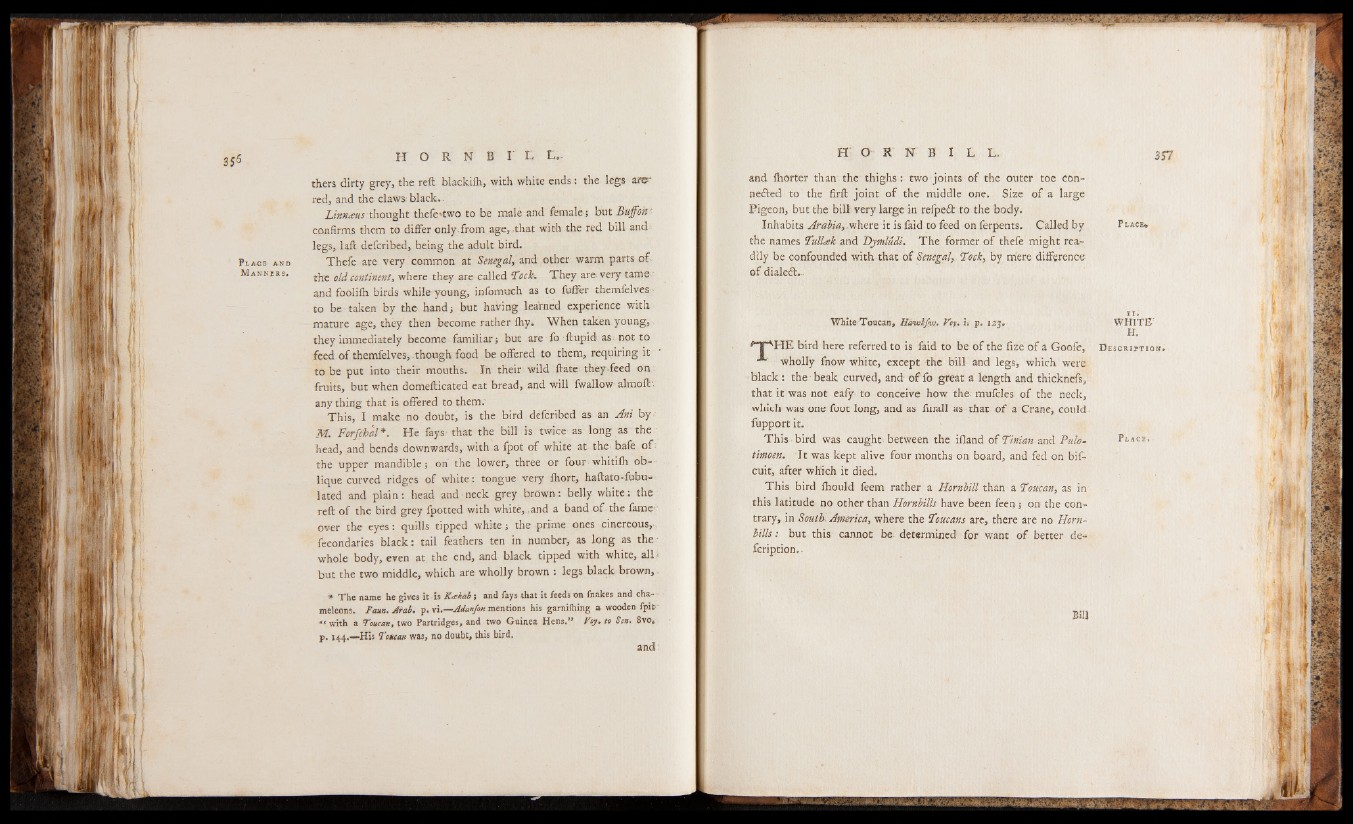
P la-ge A-ND
M a n n e r s .
thers dirty grey, the reft blackifh, with white ends: the legs ar©'
red, and the claws; black.,
Linnaus thought thefe'two to be male and female s but Bufforr
confirms them to differ only.from age,-that with the red bill and
legs, laft defcribed, being the adult bird.
Thefe are very common at Senegal, and other warm parts of
the old continent, where they are- called ‘Tuck. They are' very tame
and foolilh birds while young, infomuch as to fuller themfelves -
to be taken by the hand; but having learned experience with
mature age, they then become rather Ihy. When taken young,
they immediately become familiar; but are fo ftupid as not to
feed of themfelves, though food be offered to them, requiring it
to be put into their mouths. In their wild Hate they feed on
fruits, but when domefticated eat bread, and will fwallow almoll'
anything that is offered to them.
This, I make no doubt, is the bird defcribed as an Ani by;
M. Forfchal*. He fays-that the bill is twice as long as the
head, and bends downwards, with a fpot of white at the bale of;
the upper mandible; on the lower, three or four whitilh oblique
curved ridges of white: tongue very fhort, haftato-fubu-
lated and plain: head and neck grey brown: belly white: the
reft of the bird grey fpotted with white, ..and a band of. the fame'
over the eyes: quills tipped white; the prime ones cinereous,
fecondaries black: tail feathers ten in number, as long as the
whole body, even at the end, and black tipped with white, all
but the two middle, which are wholly brown : legs black brown,
• The name he giws it is Ktekab; and lays that it feeds on fnakes and chameleons.
Faun. Arab. p. \ i .— Adanfon mentions his garnilhing a wooden fpit
‘•with a Toucan, two Partridges, and two Guinea Hens.” Toy. to Sen. 8vo,
p. 144.—His Tmean was, no doubt, this bird.
and
and fhorter than the thighs: two joints of the outer toe con-
nedted to the firft joint of the middle one. Size of a large
Pigeon, but the bill very large in refpedt to the body.
Inhabits Arabia,.where it is laid to feed on ferpents. Called by
the names Tullak and Dymludi. The former of thefe might readily
be confounded with that of Senegal, Tock, by mere difference
of dialed!.
P lace*
White Toucan, Hawijku. Voy* i. p. 123.
VHE bird here referred to is faid to be of the fize of a Goofe,
wholly fnow white, except the bill and legs, which were
black : the beak curved, and of'fo great a length and thicknefs,
that it was not eafy to conceive how the mufcles of the neck,
which was one foot long, and as fmall as that o f a Crane, could
fupport it.
11. WHHI.TE'
D e s c r i p t io n «
This bird was caught between the ifland of Tinian and Pulo-
timoen. It was kept alive four months on board, and fed on bif-
cuit, after which it died.
This bird fhould feem rather a Hornbill than a Toucan, as in
this latitude no other than Hornbills have been feen; on the con-
trary, in South America, where the Toucans are, there are no Horn-
bills: but this cannot be determined for want o f better de-
feription.
P l a c e »
Bill